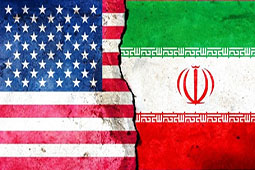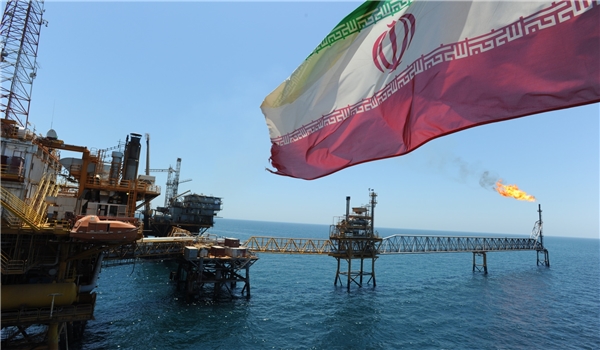
Iran’s Oil-Free Economic Conduct

Aimed at disarming the adversary which is weaponizing the oil industry against Tehran, the IPRC’s new scheme, titled “Oil-Free Economic Conduct” (OFEC), is hoped to be the trump card in winning the battle of sanctions and an opportunity to correct the economic structure of the country.
The IPRC said in a statement, “Even if Iran’s oil exports are cut to zero, it is still feasible, with some amendments [in structures], to balance the payments and the foreign exchange market.”
“The most efficient and stable way to counter the lever of oil sanctions is the willful running of the country without oil [revenues],” highlighted the statement.
The scheme, proposed to govern the country without oil revenues, is drafted in two sections, recounts the communique published along with the plan.
The first part is focused on a voluntary plan for abstaining the general budget of the government from oil revenues, which highlights that it does not necessarily mean that the country must stop selling oil.
The second part expounds on the methods to defuse the negative effects of the hypothetical condition of the country’s oil exports being reduced or even cut to zero, in order to still balance the payments and the relevant markets of the country.
The statement adds that the current plan is after enabling the executive body of the country to stop its budget dependency on oil revenues, from the very early stages of putting it into practice, in a practical and executable way, with least social and political friction, without roiling the mega-economic environment of the country, and with considering the needed supports for vulnerable strata of the society.
It states that the plan is expected to help the country to keep balances during the time of executing the scheme, and enter the national economy into a new age of planning independent from sources like oil and mining products.
The statement underlines that even after the anti-Iran sanctions are eased, the economy will still be able to keep its stability.
The plan for zeroing the country’s budget dependence on oil revenues is expected to bolster Iran’s economy to be immune to oil shocks and fluctuations, and to elevate this new change into the main feature of the country’s budget drafting.
Meanwhile, the scheme will leave the oil resources of the country as a reliable source for the posterity to use it in a more stable situation with diversification of economy and better trade conditions.
The communique adds that the plan starts its path with a clear-sighted understanding of the country’s budget deficit after removing the revenues from oil exports from the list of the national revenues.
The calculated numbers will be marked as the index recounting the gap between an unhealthy and healthy economy and general budget. It will tell the government, its staff, and the nation that how much work is needed to compensate for ruling out oil revenues from the list of collections.
After utilizing the budget tools in allocating for the current and construction expenses and with selling equity warrants, the IPRC says, “Our estimation is that the budget deficit [caused] by removing the oil [earnings from the revenues sector] will be around 100 trillion rials, which is not a big volume vis-à-vis the economic potentials of the country and is possible to be made up for by coordinated measures in making and implementing policies.”
It adds that the plan is comprised of a ten-fold policy set with an average of 10 trillion rial revenues and savings for the country.
Recounting that part of the plan could be put into effect in the next years, the IPRC says that some parts of the plan are suitable to be implemented this year and capable to make revenues in the current year, including a number of changes in the tax system of the country.
“Warrants of clearing the country’s economy from oil” is the title for some securities to be released in the next year.
“Estimates are indicating that the country will make new revenues at around 60 to 70 trillion rial in the current year with implementing the new policies,” the statement underscores.
From the very moment that the plan is practiced, with the ratification of the amendment bill for the current year’s budget act, the stream of oil revenues to the government’s coffer will be dried off and the oil earnings of the country will be put into the National Fund of Development, after detracting the share of the National Oil Company, the statement said.
The National Fund of Development is allowed to deposit the resources in the Central Bank of Iran, following its current procedures and statute.
According to the plan, oil constructions will be since then financed through the National Fund of Development, and not from the general budget of the country, which means that fluctuations in oil prices will have zero effects on daily affairs of the country and the oil revenues will be used in an inter-generational method.
Beside voluntary cut in using oil revenues in the general budget of the country, the second part of the plan seeks stable economic situation through balancing payments should the country’s oil revenues be choked off by the US’ unilateral sanctions.
However, the statement says that the plan to cut Iran’s oil revenues to zero will never be materialized in the real world. “However, the most logical method for planning is, when it comes to foreseeing different scenarios, to bear in mind the worst conditions in their far extreme end of the spectrum,” reads the communique.
The strategies for balancing the payments is made up of a three-fold set of programs which firstly prioritizes comprehensive and meticulous management of the current resources of foreign currencies with a more effective contracting to ensure the return of the revenues from exports to the country.
“Last year, the country exported $44 billion of non-oil goods, and part of this figure has not been presented in the integrated [Iranian] foreign exchange platform (NIMA),” the IPRC said, calling for more transparency in this part.
The integrated Iranian foreign exchange platform or also briefly called NIMA was launched in February 2018 by Central Bank of Iran, aiming to facilitate trades and providing needed foreign exchange, creating a secure and competitive environment for buyers and sellers and currency exchange houses.
The first part of the three-fold set of programs for balancing the payments, also criticizes some shortcomings which are urged to be resolved for increasing the efficacy of the plan.
The second step in the three-fold set of programs for balancing the payments highlights that the expenditure of the current foreign currency revenues of the country must be strictly monitored and managed.
It underscores other ways for increasing the inflow of foreign currencies into the country with imposition of some restrictions and new tariffs for unnecessary and luxury goods.
The third step is about creating new sources of foreign revenues with encouraging unofficial exports to get channeled in official routes. Increasing the export of energy carriers and boosting regional tourism are in sight in this part of the plan.
This step will approximately bring $40 billion for the country, which alone will exceed the revenues of oil and gas exports which at its best hit at $30 billion.
The IPRC asserted that the plan can be revised and improved with further comments and feedbacks from experts and economists.
With finalization of the draft for the plan, the IPRC said, the heads of three branches of the country and the government will lay out the details for executing it.



Trump weighs using $2 billion in CHIPS Act funding for critical minerals

Codelco cuts 2025 copper forecast after El Teniente mine collapse

Electra converts debt, launches $30M raise to jumpstart stalled cobalt refinery

Barrick’s Reko Diq in line for $410M ADB backing

Abcourt readies Sleeping Giant mill to pour first gold since 2014

Nevada army depot to serve as base for first US strategic minerals stockpile

SQM boosts lithium supply plans as prices flick higher

Viridis unveils 200Mt initial reserve for Brazil rare earth project

Tailings could meet much of US critical mineral demand – study

Kyrgyzstan kicks off underground gold mining at Kumtor

Kyrgyzstan kicks off underground gold mining at Kumtor

KoBold Metals granted lithium exploration rights in Congo

Freeport Indonesia to wrap up Gresik plant repairs by early September

Energy Fuels soars on Vulcan Elements partnership

Northern Dynasty sticks to proposal in battle to lift Pebble mine veto

Giustra-backed mining firm teams up with informal miners in Colombia

Critical Metals signs agreement to supply rare earth to US government-funded facility

China extends rare earth controls to imported material

Galan Lithium proceeds with $13M financing for Argentina project

Kyrgyzstan kicks off underground gold mining at Kumtor

Freeport Indonesia to wrap up Gresik plant repairs by early September

Energy Fuels soars on Vulcan Elements partnership

Northern Dynasty sticks to proposal in battle to lift Pebble mine veto

Giustra-backed mining firm teams up with informal miners in Colombia

Critical Metals signs agreement to supply rare earth to US government-funded facility

China extends rare earth controls to imported material

Galan Lithium proceeds with $13M financing for Argentina project

Silver price touches $39 as market weighs rate cut outlook

















